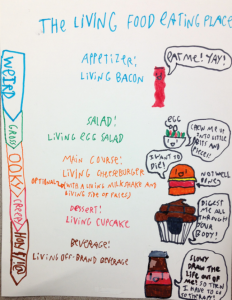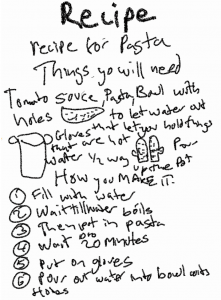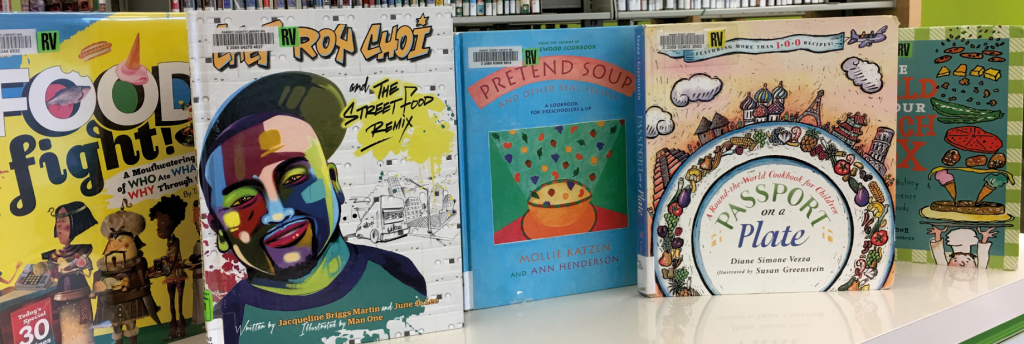9 Menus & Recipes
Were I to investigate, I bet I’d find that cookbooks comprise one of the leading informational subject areas in circulation statistics at my school library. For children in third grade and younger, they’d be right up there with dinosaurs. When I was a new public librarian, the first Dewey number I could rattle off from memory was 651.5. As a school librarian, I didn’t need to run a report to see that among the library’s highest circulating books were the Star Wars cookbooks. Chronicle Books, which publishes these titles, has reported that more than half a million copies have been sold to date. And in the Writing Boxes workshops, I’ve found that the recipes and menus programs often lead to the most animated writing sessions.


I attribute the high interest in cookbooks to a few factors. Most of us like to eat, for one thing. And for many children, cookbooks are an easy read. They’re predictable in format, and you don’t have to cook to enjoy them. Some, like Pretend Soup, have step-by-step illustrations to follow.
Cooking is one of the first family literacy experiences a child has with an adult. The simple question “What do we need from the store to make cookies?” introduces a child to lists, to the act of decoding symbols on a page, and to the connection of those symbols to ingredients at the store and, later, in the mixing bowl.
Creating and writing a recipe is another process that supports family literacy. Writing recipes is the perfect intergenerational activity. Adults can take dictation, or young writers can. It’s a shared experience.
This type of procedural writing can be adapted for other types of do-it-yourself projects. In writing programs, prompts for recipes (“How do I make applesauce?” “How do I bake bread?”) can be opened up for other activities (” How do I make a paper airplane?” How do I start using Minecraft?” or cross-curriculum, “How do I draw a cartoon of a cat?”).
Notes on the Recipes Program
I usually begin by asking, “Does anyone know how to cook?” “YES!” “Grilled cheese!” “Scrambled eggs!” ” Mac and cheese!” “Salad!” I choose a child who named something pretty simple and ask them to teach me how to make it.
What do I need to make scrambled eggs? I write the list of ingredients and draw a simple sketch of each. Am I missing anything? I write the names of any additional ingredients and draw a picture of each.
- “What do I make it in?” I ask.
- “A pan,” states the writer.
- I write “pan” and draw a picture of it.
- “Mix the eggs with milk,” says the writer”
- “How many eggs?” “In what? With what?” “How much milk?”
- “Two eggs, in a bowl, with a fork,” says the writer, “and a splash of milk”
- I list the ingredients and write the instructions.
- “Then I cook the eggs? With what?”
- “On the stove.’”
- “How do I know how to set the stove?”
- “Oh, turn the burner to medium.”
- “Stir the eggs,” instructs the writer.
- “With what?” I ask.
- “A spoon.”
I add spoon to the list of tools, label it, write the next instruction, and mime the act of stirring.
- “Take them out of pan when finished,” the writer says.
- “How do I know when they are finished?”
- “They are hard and not wet,” says the recipe writer.
For a writing session, we can do either topic or both on two different days.

Mentor texts
Ainsworth, Mark, and Culinary Institute of America. 2016. The Young Chef: Recipes and Techniques for Kids Who Love to Cook. Boston: Houghton Mifflin Harcourt.
Bucholz, Dinah. 2012. The Unofficial Narnia Cookbook: From Turkish Delight to Gooseberry Fool. Naperville, IL: Sourcebooks Jabberwocky.
Bugni, Alice, and Erik Brooks. 2016. Beluga Whales, Grizzly Tales, and More Alaska Kidsnacks: Fun Recipes for Cooking with Kids. Seattle, WA: Little Bigfoot.
Cherkasky, Lisa, and Elisa Chavarri. 2016. You’re the Chef! A Cookbook Companion for a Smart Girl’s Guide: Cooking. Middleton, WI: American Girl Publishing.
Colella, Jill, Katharine Ibbs, Nicola Graimes, and Denise Smart. 2015. Complete Children’s Cookbook. New York: DK Publishing. still image.
D’Amico, Joan, Karen Eich Drummond, and Tina Cash-Walsh. 1997. The Math Chef: Over 60 Math Activities and Recipes for Kids. New York: J. Wiley.
French, Deborah, and Leah Ehrlich. 2015. The Cookbook for Children with Special Needs: Learning a Life Skill with Fun, Tasty, Healthy Recipes. London: Jessica Kingsley Publishers.
Grant, Amanda, and Harriet Russell. 2009. The Silver Spoon for Children: Favorite Italian Recipes. New York: Phaidon.
Gunard, Sebastien, and Aladjidi Virginie. 2014. Big Meals for Little Hands: Flying Eye Books.
Hartland, Jessie. 2012. Bon Appetit! The Delicious Life of Julia Child. New York: Schwartz & Wade Books.
Katzen, Mollie. 1999. Honest Pretzels: And 64 Other Amazing Recipes for Cooks Ages 8 & Up. Berkeley, CA: Tricycle Press.
Katzen, Mollie, and Ann Henderson. 1994. Pretend Soup and Other Real Recipes: A Cookbook for Preschoolers & Up. Berkeley, CA: Tricycle Press.
Knisley, Lucy. 2013. Relish: My Life in the Kitchen. New York: First Second.
Marsico, Katie. 2015. Kitchen Math, Math Everywhere! Minneapolis: Lerner.
McCallum, Ann, and Leeza Hernandez. 2011. Eat Your Math Homework: Recipes for Hungry Minds. Watertown, MA: Charlesbridge.
McQuillan, Susan. 2015. Let’s Cook! Boston; New York: Houghton Mifflin Harcourt.
Mendez, Sean. 2011. One World Kids Cookbook: Easy, Healthy, and Affordable Family Meals: Interlink Pub Group.
Miller, Pat, and Vincent X. Kirsch. 2016. The Hole Story of the Doughnut. Boston: Houghton Mifflin Harcourt.
Morris, Ann, and Ken Heyman. 1989. Bread, Bread, Bread. New York: Lothrop, Lee & Shepard Books.
Palatini, Margie, and Howard Fine. 1995. Piggie Pie. New York: Clarion Books.
Pépin, Claudine, and Jacques Pépin. 2015. Kids Cook French = Les Enfants Cuisinent à La Franc̦Aise. Beverly, MA: Quarry Books.
Robertson, Emma, Emilia Terragni, Tara Stevens, Adriano de Campos Rampazzo, and Colin White. 2014. Chop, Sizzle, Wow: 50 Step-by-Step Kitchen Adventures. New York, New York: Phaidon Press Ltd.
Ruhlman, Michael. 2009. Ratio: The Simple Codes Behind the Craft of Everyday Cooking. New York, NY: Scribner.
Sampson, Sally, and Carl Tremblay. 2013. Chopchop: The Kids’ Guide to Cooking Real Food with Your Family. New York: Simon & Schuster Paperbacks.
Seaver, Barton. 2014. National Geographic Kids Cookbook: A Year-Round Fun Food Adventure. Washington, D.C.: National Geographic.
Starr, Lara. 2014. The Very Hungry Caterpillar Cookbook: Chronicle Books.
Waters, Alice, Bob Carrau, Patricia Curtan, and Ann Arnold. 1992. Fanny at Chez Panisse. New York: HarperCollins Publishers.
Winslow, Marjorie, and Erik Blegvad. 2010. Mud Pies and Other Recipes. New York: New York Review of Books.
Resources
Morawek, Alison. 2011. “Get Cooking with Words! Creating a Recipe Using Procedural Writing.” z.umn.edu/wbr56.

